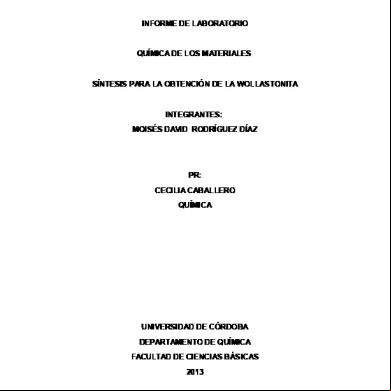Format Of Front Page Of Chemistry Project 1e3gj
This document was ed by and they confirmed that they have the permission to share it. If you are author or own the copyright of this book, please report to us by using this report form. Report l4457
Overview 6h3y3j
& View Format Of Front Page Of Chemistry Project as PDF for free.
More details h6z72
- Words: 445
- Pages: 7
THE QUALITATIVE ANALYSIS OF VARIOUS SOFT DRINKS CHEMISTRY-AISSCE PROJECT DAV PUBLIC SCHOOL BSEB COLONY, PATNA
NAME : MILIND RAJ DIXIT CLASS : XII SECTION: MA ROLL NUMBER :
This is actually a heating test to find the amount of residue left in various soft
drinks
after
heating.
This
ultimately tells us about the level of sugar present in various soft drinks. In the test of the sample (5 ml) of each soft drink is taken in separate china dishes and heated for sufficient time to dry it out. Then the residue left is studied. It was observed that the maximum amount of residue was left in the
case of Gold Spot while minimum in Soda.
Soft drinks provide large amounts of sugars (mostly high fructose corn syrup) to many individuals’ diet. The calories of soft drinks are likely
to
contribute
particularly
to
overweight
health
and
problems,
obesity.
Those
conditions have become far more prevalent during
the
consumption
period has
in
soared.
which
soft
Several
drink
scientific
studies have provided experimental evidences that soft drinks are directly related to the weight gain. The weight gain, in term is a prime risk factor for type 2 diabetes, which for the first time, is becoming a problem for teens as well as adults.
As people get older, excess
weight also contribute to heart attacks, strokes and cancer. Frequent consumption of soft drinks may also increase the risk of osteoporosis especially in people who drink soft drinks instead of calcium rich milk. Dental experts urge the people to drink less soda pap, especially between meals, to prevent tooth decay (due to sugars) and dental erosion (due to acids). Frequent consumers of soft drinks may also be at a higher risk of kidney stones and a slightly higher risk of heart disease. More research is needed in both of these areas. Researches
around
the
world
has
thus
established beyond doubts that soft drinks consumption is injurious to health.
CONCLUSION
In the end I would like to mention about the important results in this interesting and exciting project. Most of the brands of the soft drinks are chemically very similar except the soda water which is actually carbonated water and cannot be considered as soft drink. All the brands have glucose, sucrose and ethyl alcohol except soda. The difference lies only in the color, name of the brands and its flavor. This is the reason why everyone’s favorite brand keeps on changing and to satisfy the public, companies keep changing the colors and the flavors.
Comprehensive Chemistry by N.K.Verma.
Dr.
Pradeep’s New Course Chemistry By S.C.Kheterpal. ABC of Chemistry. Lab Manual Chemistry By Book Depot.
In Arya
NAME : MILIND RAJ DIXIT CLASS : XII SECTION: MA ROLL NUMBER :
This is actually a heating test to find the amount of residue left in various soft
drinks
after
heating.
This
ultimately tells us about the level of sugar present in various soft drinks. In the test of the sample (5 ml) of each soft drink is taken in separate china dishes and heated for sufficient time to dry it out. Then the residue left is studied. It was observed that the maximum amount of residue was left in the
case of Gold Spot while minimum in Soda.
Soft drinks provide large amounts of sugars (mostly high fructose corn syrup) to many individuals’ diet. The calories of soft drinks are likely
to
contribute
particularly
to
overweight
health
and
problems,
obesity.
Those
conditions have become far more prevalent during
the
consumption
period has
in
soared.
which
soft
Several
drink
scientific
studies have provided experimental evidences that soft drinks are directly related to the weight gain. The weight gain, in term is a prime risk factor for type 2 diabetes, which for the first time, is becoming a problem for teens as well as adults.
As people get older, excess
weight also contribute to heart attacks, strokes and cancer. Frequent consumption of soft drinks may also increase the risk of osteoporosis especially in people who drink soft drinks instead of calcium rich milk. Dental experts urge the people to drink less soda pap, especially between meals, to prevent tooth decay (due to sugars) and dental erosion (due to acids). Frequent consumers of soft drinks may also be at a higher risk of kidney stones and a slightly higher risk of heart disease. More research is needed in both of these areas. Researches
around
the
world
has
thus
established beyond doubts that soft drinks consumption is injurious to health.
CONCLUSION
In the end I would like to mention about the important results in this interesting and exciting project. Most of the brands of the soft drinks are chemically very similar except the soda water which is actually carbonated water and cannot be considered as soft drink. All the brands have glucose, sucrose and ethyl alcohol except soda. The difference lies only in the color, name of the brands and its flavor. This is the reason why everyone’s favorite brand keeps on changing and to satisfy the public, companies keep changing the colors and the flavors.
Comprehensive Chemistry by N.K.Verma.
Dr.
Pradeep’s New Course Chemistry By S.C.Kheterpal. ABC of Chemistry. Lab Manual Chemistry By Book Depot.
In Arya









